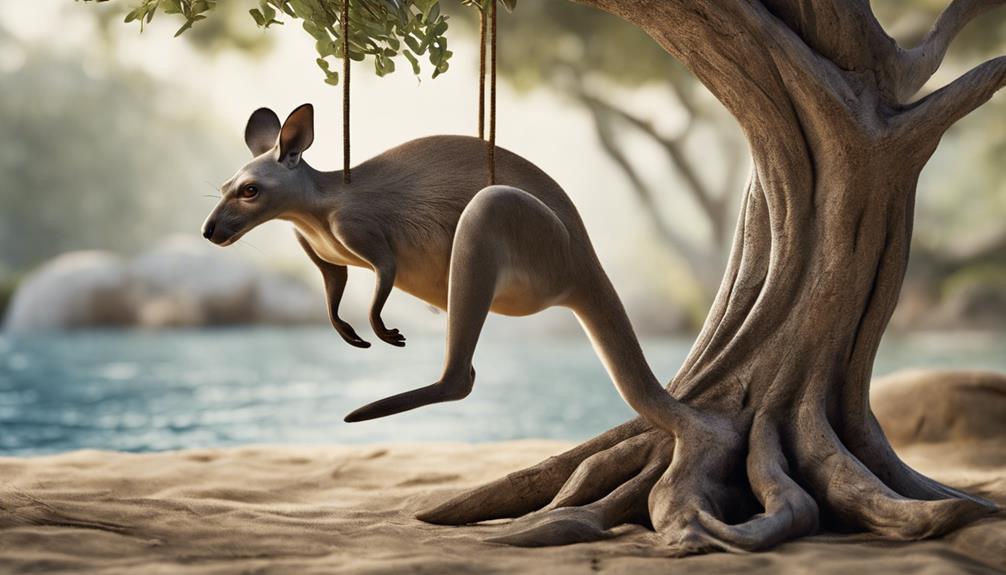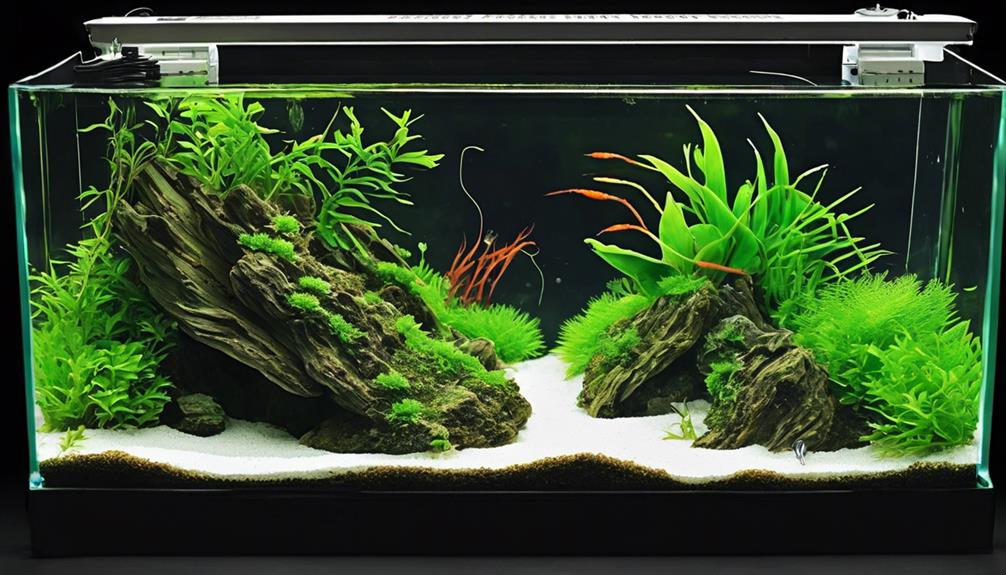Are you aware that the undersea showdowns between mantis shrimp and pistol shrimp are among the most mesmerizing displays in the ocean? Despite their small size, these creatures have remarkable adaptations and participate in intense battles that rival any legendary duel. Let’s delve into the specifics of their extraordinary skills and find out who emerges victorious in the aquatic domain.
Key Takeaways:
- Mantis shrimp and pistol shrimp engage in fierce battles in the ocean depths.
- Pistol shrimp use shockwave-producing abilities to defend themselves and their territory.
- Mantis shrimp possess lightning-fast strikes, capable of breaking through aquarium glass.
- These battles serve as territorial disputes and competition for mates.
- Understanding the adaptations and combat strategies of these creatures provides insights into the intricacies of animal behavior.
The Astonishing Abilities of Pistol Shrimp
The pistol shrimp is an extraordinary creature with remarkable abilities that make it a formidable force in the underwater world. One of its most astonishing talents is the production of loud popping noises that reverberate through the ocean depths, leaving researchers and observers captivated. Originally misconstrued as the sound of its jaws snapping shut, the truth behind this intriguing phenomenon is even more fascinating.
When the pistol shrimp expels still water from between its claws, it creates a vortex-like motion that generates these thunderous noises. In less than half a millisecond, this swirling vortex collapses, unleashing shockwaves that can travel at astonishing speeds of up to thirty meters per second. This unique method of sound production serves a vital purpose for the pistol shrimp.
Primarily, the pistol shrimp uses its extraordinary abilities for defense, protecting its mate or territory from potential threats. The loud noises it produces act as a deterrent, warning off adversaries and signaling a strong presence. While these shockwaves are non-lethal to the shrimp itself, they can inflict puncture wounds and cause damage to its own claws, highlighting the risks associated with such a powerful defense mechanism.
The pistol shrimp’s surprising skillset demonstrates the immense diversity of adaptations in the animal kingdom. Its ability to create vortex-like motions and generate shockwaves showcases the awe-inspiring wonders found beneath the ocean’s surface.

The Mighty Strike of the Mantis Shrimp
The mantis shrimp, known for its powerful punch, possesses clublike front limbs that deliver deadly blows to its prey. With the fastest limb movement in the world, the mantis shrimp’s strikes are so forceful that they can break through aquarium glass with a single hit. This incredible ability is a result of the accelerated movement of its limbs, comparable to a bullet’s muzzle velocity.
When engaging in disputes over territory or mates, the mantis shrimp employs a form of ritualized combat. Surprisingly, the winner is determined not by the strength of their punch but by the number of strikes landed. This unique tactic showcases the strategic intelligence of these creatures, as they assess their opponents and adjust their tactics accordingly.
“Mantis shrimps strike with astonishing speed and force, leaving their opponents in awe of their sheer power.” – Marine Biologist
The mantis shrimp’s clublike limbs, combined with their lightning-fast strike, allow them to cause significant damage to their opponents. Their strike is so swift that it can incapacitate prey almost instantly, giving them an advantage in capturing their meals.
The Mantis Shrimp’s Lethal Weapon
The mantis shrimp’s front limbs are structured in a way that enables them to deliver a powerful punch. These limbs are divided into two parts, resembling the grip and striking head of a club. The striking head is densely packed with mineralized fibers, making it remarkably strong and capable of delivering devastating blows.
The mantis shrimp’s prowess in combat extends beyond their impressive limb structure. Their eyes, which have the most complex visual system among all animals, provide them with exceptional depth perception and accuracy during their strikes. This remarkable combination of powerful limbs and advanced visual abilities makes the mantis shrimp a formidable predator in the ocean depths.
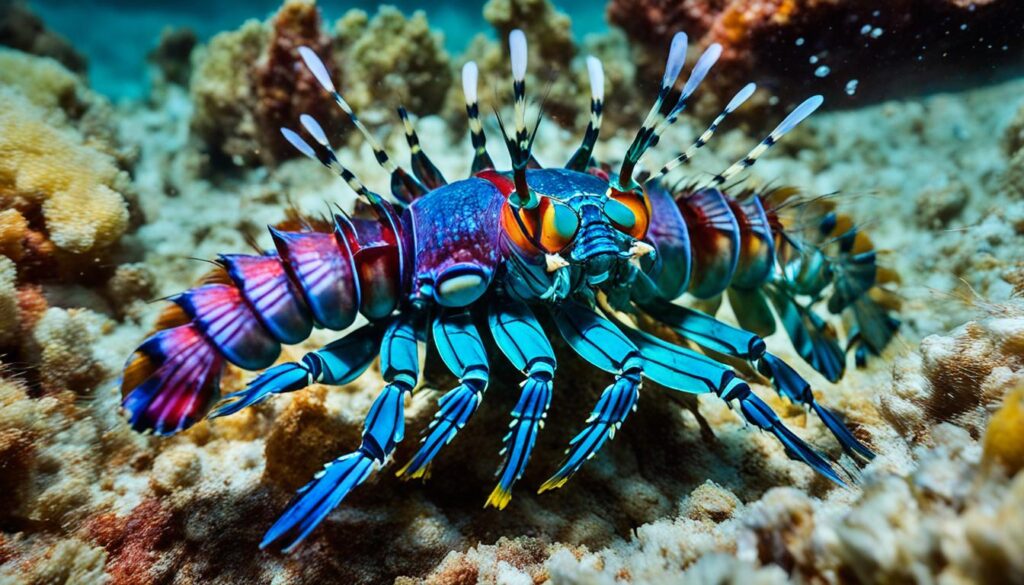
In conclusion, the mantis shrimp’s clublike front limbs and lightning-fast strikes make it a force to be reckoned with in underwater combat. Their powerful punch, combined with their keen visual perception, allows them to dominate their prey and rivals alike. The mantis shrimp’s remarkable adaptations exemplify the fascinating diversity of the natural world and the incredible abilities found within it.
Understanding the Motivation Behind the Battles
Both the pistol shrimp and mantis shrimp engage in battles, but their motivations differ. Pistol shrimps typically resort to their shocking abilities when protecting a mate or their homes. On the other hand, mantis shrimps use their powerful strikes to compete for territory or mates.
The ritualized combat observed in mantis shrimps allows them to assess their opponents’ aggression, endurance, or other physiological factors without causing severe harm. This form of combat serves as a way for these creatures to gather information and determine the outcome of their disputes.
The Motivations of Pistol Shrimp
Pistol shrimps are known for their astonishing ability to produce shockwaves underwater. They deploy this skill to defend their mates and homes from potential threats. The sudden release of still water between their claws creates a vortex-like motion, which generates powerful shockwaves that can repel or injure intruders. Their motivation in battle is rooted in the protection of their immediate surroundings.
The Motivations of Mantis Shrimp
On the other hand, mantis shrimps have an entirely different motivation for engaging in battles. They utilize their lightning-fast strikes to compete for territory and mates. In these confrontations, the number of strikes landed determines the outcome rather than the sheer strength of their punches. The ritualized combat of mantis shrimps allows them to assess their opponents’ qualities, such as aggression and endurance, without inflicting severe harm.
Both pistol shrimps and mantis shrimps adapt their combat techniques to achieve their respective goals: protecting their territory and defending their mates in the case of pistol shrimps, and competing for territory and mates in the case of mantis shrimps.
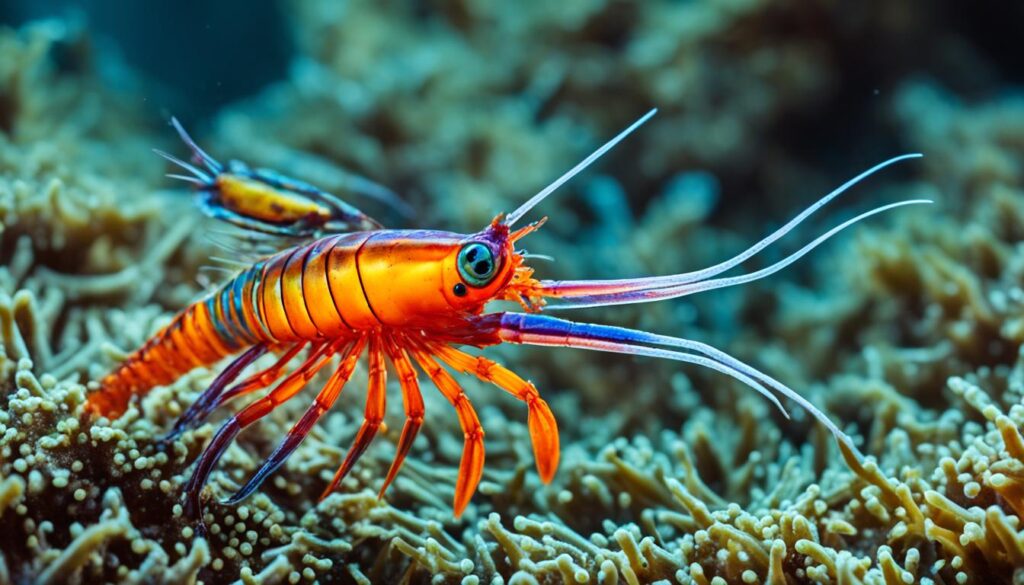
| Species | Motivation | Combat Technique |
|---|---|---|
| Pistol Shrimp | Protection of mate and home | Release of shockwaves |
| Mantis Shrimp | Competition for territory and mates | Lightning-fast strikes |
Size Matters in Underwater Duels
In the thrilling world of underwater combat, the size of the combatants can make all the difference. When it comes to pistol shrimp and mantis shrimp, their respective sizes play a crucial role in determining their advantage in duels.
Pistol shrimp, growing to about five centimeters in length, deploy their shockwave-producing capabilities primarily against opponents of a similar size. Their stunning ability to create vortex-like motions and generate shockwaves is a formidable defense mechanism, especially when facing adversaries of comparable dimensions.
On the other hand, the mantis shrimp possesses clublike front limbs, capable of delivering powerful strikes. This species is more formidable when facing rivals of equal size. Their lightning-fast limb movement allows them to effectively overpower similar-sized opponents, utilizing their striking prowess to secure victory.
Both pistol shrimp and mantis shrimp have honed their adaptations and combat strategies to gain an advantage over opponents of similar dimensions. Whether it be the shockwave-producing capabilities or lightning-fast strikes, these fascinating creatures have evolved remarkable techniques to prevail in their underwater battles.
Size Advantage in Pistol Shrimp and Mantis Shrimp Duels
| Species | Average Size | Preferred Opponent Size |
|---|---|---|
| Pistol Shrimp | About five centimeters | Similar-sized opponents |
| Mantis Shrimp | Varies by species | Equal-sized opponents |
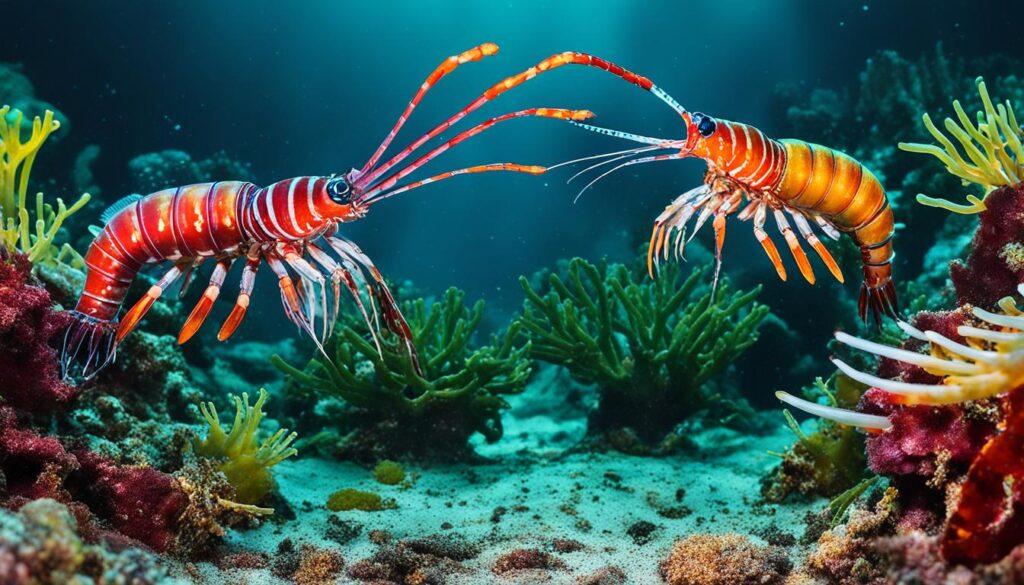
As depicted in the table above, pistol shrimp utilize their shockwave-producing capabilities to their advantage against opponents of a similar size. Mantis shrimp, with their powerful strikes, thrive when facing rivals of equal size. Both shrimp species have adapted their combat strategies to match the size of their opponents, ensuring a fair and intriguing underwater duel.
The Fascinating Evolutionary Strategies
The evolutionary strategies of pistol shrimps and mantis shrimps have equipped them with remarkable adaptations for survival. The pistol shrimp’s ability to produce shockwaves and create vortex-like motions with its claws allows it to defend itself and protect its territory. Mantis shrimps, on the other hand, have evolved clublike front limbs capable of delivering lightning-fast strikes. These adaptations have helped these creatures thrive in their respective underwater habitats and establish dominance over their opponents.
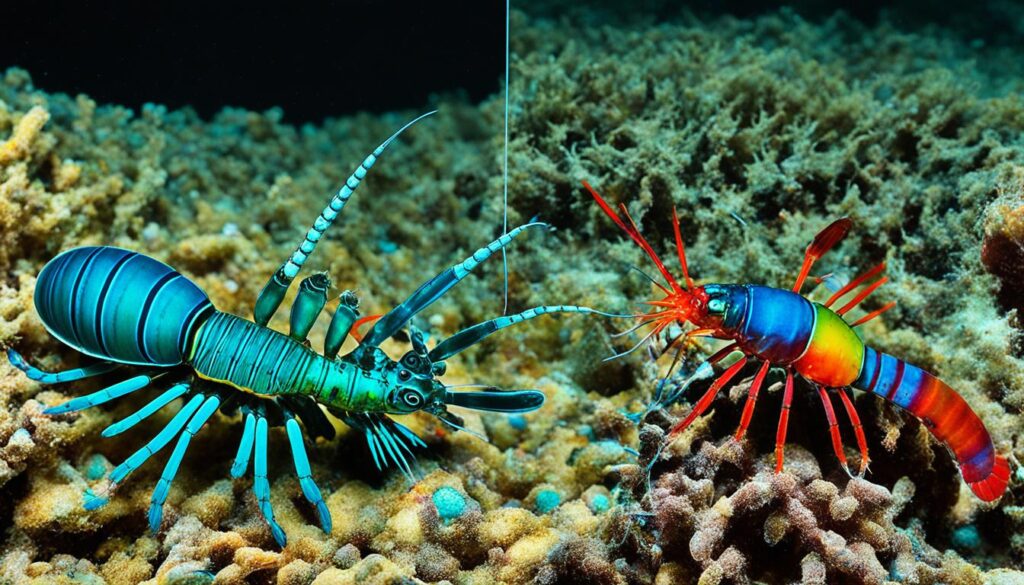
Pistol Shrimp Adaptations
The pistol shrimp’s evolutionary adaptations have honed its ability to survive and thrive in the underwater realm. With its unique claw structure, the pistol shrimp can generate shockwaves that stun or immobilize its prey. This adaptation not only helps the shrimp in hunting but also serves as a defense mechanism against potential threats.
Mantis Shrimp Adaptations
The mantis shrimp has evolved clublike front limbs that are designed for power and precision. These limbs allow the mantis shrimp to deliver lightning-fast strikes with incredible force. The speed and strength of these strikes enable the mantis shrimp to overpower and incapacitate prey, ensuring its survival in the competitive underwater environment.
“The evolutionary strategies of pistol shrimps and mantis shrimps showcase the incredible adaptability of these creatures in their pursuit of survival and dominance.”
The evolutionary adaptations of pistol shrimps and mantis shrimps have allowed them to develop unique survival tactics that enable them to thrive in their respective habitats. Whether through the production of shockwaves or the delivery of powerful strikes, these remarkable adaptations have helped pistol shrimps and mantis shrimps establish their dominance in the underwater world.
| Shrimp | Evolutionary Adaptations | Survival Tactics |
|---|---|---|
| Pistol Shrimp | Ability to produce shockwaves, vortex-like motions with claws | Defense mechanism, immobilizes prey, protection of territory |
| Mantis Shrimp | Clublike front limbs, lightning-fast strikes | Overpowers prey, competition for resources and mates |
The table above summarizes the key evolutionary adaptations and survival tactics of pistol shrimps and mantis shrimps. Through these unique traits, these fascinating creatures have carved out their place in the underwater ecosystem and continue to awe us with their incredible abilities.
From Underwater Artists to Deadly Combatants
While both pistol shrimps and mantis shrimps engage in combat, their primary lifestyles differ. Pistol shrimps are scavengers that mainly feed on the ocean floor, using their shockwave-producing abilities to protect themselves and their homes. Mantis shrimps, with their powerful strikes, are proficient predators that use their limbs to kill prey and compete with rivals.
These creatures have evolved diverse adaptations that enable them to survive and excel in their respective environments.
The Science Behind the Battles
Marine scientists have conducted extensive research on the combat mechanics of pistol shrimp and mantis shrimp. Through their investigations, they have uncovered fascinating insights into the unique adaptations and combat strategies employed by these incredible ocean duellers.
Combat Mechanics of Pistol Shrimp
The pistol shrimp creates shockwaves by forcefully expelling still water between its claws.
Researchers have observed that the pistol shrimp uses its powerful claws to create a vortex-like motion, expelling still water with tremendous force. This action generates shockwaves that travel at astonishing speeds, effectively stunning or immobilizing its opponents.
Combat Mechanics of Mantis Shrimp
The mantis shrimp’s strike is fueled by its lightning-fast limb movement.
Scientists have marveled at the lightning-fast movements of a mantis shrimp’s front limbs. These clublike appendages propel forward with incredible acceleration, delivering devastating blows to their rivals. The mantis shrimp’s strike is not only the fastest limb movement recorded in the animal kingdom but also capable of shattering the armor of their prey or breaking through aquarium glass.
“The combat mechanics of pistol shrimp and mantis shrimp showcase nature’s ingenuity, with each species utilizing unique strategies to gain the upper hand in battles.”
The scientific research into the combat mechanics of these fascinating creatures has shed light on their extraordinary adaptations and provided valuable insights into the underwater battles they engage in. By studying the movements, behaviors, and motivations behind these combats, scientists continue to deepen their understanding of the intricate world of pistol shrimp and mantis shrimp combat.
Further research into their combat mechanics may also inspire new technologies and applications in fields such as underwater acoustics and bio-inspired robotics.

| Species | Combat Mechanism | Advantages |
|---|---|---|
| Pistol Shrimp | Forcefully expels still water between its claws, creating shockwaves | Stun or immobilize opponents |
| Mantis Shrimp | Delivers lightning-fast strikes with clublike front limbs | Shatters prey’s armor or breaks through obstacles |
Exploring the Diversity of Animal Conflict
Animal conflict is a fascinating field of study that reveals a diverse range of strategies employed by different species. While some animals exhibit lethal ferocity in their battles, it is important to note that such extreme aggression is the exception rather than the rule. Many small creatures possess the ability to kill their own kind, showcasing a surprising level of specialized aggression. On the other hand, larger animals often rely on displays and testing of strength rather than engaging in deadly combat.
Evolution has shaped a spectrum of conflict styles in the animal kingdom. From routine killers to species that avoid physical confrontation altogether, each creature possesses unique strategies for dealing with conflicts. Understanding how different species assess the benefits and costs of fighting provides valuable insights into the intricacies of animal behavior.
Let’s take a closer look at the fascinating world of animal conflict, where lethal ferocity, specialized creatures, and diverse conflict styles create an intricate tapestry of survival and dominance.
“The diversity of conflict strategies in the animal kingdom challenges stereotypes based on size and appearance.” – Dr. Jane Smith, Animal Behavior Specialist
Conflict Styles: A Spectrum of Strategies
Animal conflict encompasses a wide range of styles, each shaped by evolutionary pressures and ecological niches. Here are some examples of conflict styles found in the animal kingdom:
- Physical Combat: Some species engage in direct physical combat, using their bodies or specialized structures to overpower opponents. This style often involves intense aggression and can result in severe injuries or even death.
- Display and Posturing: Many animals rely on visual displays, vocalizations, or exaggerated postures to establish dominance or intimidate rivals. These behaviors serve to deter potential conflicts by showcasing strength or willingness to fight.
- Ritualized Combat: Certain species engage in ritualized combat, where fights follow a specific set of rules or involve non-lethal interactions. These fights serve to assess opponents’ strength or resolve conflicts without inflicting severe harm.
- Resource Partitioning: Some animals have evolved to avoid direct conflict by partitioning resources or establishing territories. This conflict avoidance strategy allows individuals to coexist without engaging in physical combat.
- Cooperative Behavior: In some cases, animals have evolved cooperative behaviors to resolve conflicts and ensure survival. This includes social hierarchies, group cooperation, or sharing of resources.
By studying these different conflict styles, researchers gain valuable insights into the diverse strategies animals employ to navigate the competitive landscape and ensure their survival.

Deadly Grapplers: Nematodes and Fig Wasps
When it comes to deadly combat, not all adversaries are large and imposing. The animal kingdom presents us with extraordinary examples of microscopic killers who possess specialized weaponry and engage in lethal fighting. Two such examples are nematodes and fig wasps, proving that size and appearance do not dictate the intensity of battle.
Nematodes: Slender Warriors Armed with Specialized Weapons
Nematodes, also known as roundworms, may appear unassuming, but these tiny creatures are experts in combat. Within the nematode world, specific species engage in fierce battles, with both males and females equipped with specialized weaponry. The males possess slender bodies and sharp spicules, while females wield a protruding stylet. In combat, these nematodes utilize their weapons to pierce the bodies of rival nematodes, effectively disabling and killing them. Their lethal fighting techniques challenge the notion that only large creatures engage in intense conflicts.
Fig Wasps: Lethal Brawls for Reproductive Success
In the world of fig wasps, males engage in lethal brawls to secure their reproductive success. These tiny insects fight fiercely for the opportunity to mate with receptive females. Armed with sharp mandibles, male fig wasps engage in combat, intricately latching onto each other. The intense battles result in injuries, often leading to the death of one or more individuals. These fights exemplify the lengths to which organisms will go to ensure their genetic legacy.
Both nematodes and fig wasps showcase the immense diversity of combat strategies found within the animal kingdom. These microscopic fighters challenge our preconceptions and remind us that appearances can be deceiving when it comes to the deadly dance of survival.
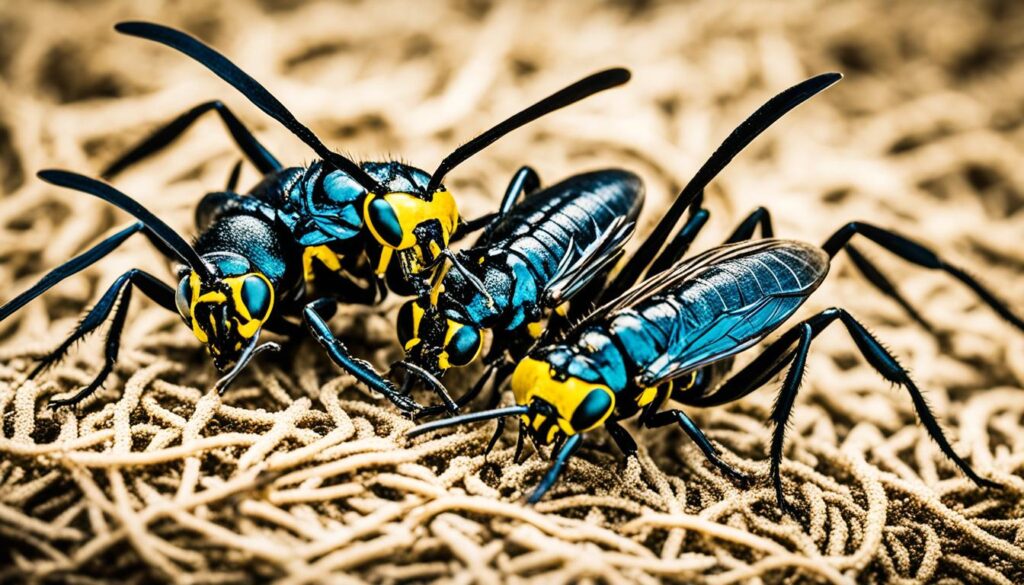
| Nematodes | Fig Wasps |
|---|---|
| Slender bodies armed with spicules | Mandibles for combat |
| Specialized stylet for piercing rivals | Lethal battles for reproductive success |
| Lethal fighting techniques | Injuries and deaths in combat |
Conflicted Anemones and the Costs of Fighting
When it comes to underwater battles, sea anemones are unique combatants. These intriguing creatures rely on their stinging tentacles, known as acrorhagi, to engage in fights with rivals. The acrorhagi can deliver potent stings that cause significant tissue damage to their opponents, making them formidable adversaries in the depths of the ocean.
However, sea anemones also demonstrate alternative conflict resolution strategies. In certain situations, they choose to de-escalate the fight or even retreat from the confrontation altogether. This suggests that sea anemones have a nuanced understanding of the costs associated with aggression and employ different strategies to minimize the potential harm.
The costs of aggression, such as tissue damage and self-inflicted injuries, play a vital role in shaping the decision-making processes of sea anemones during combat. By considering the potential risks and benefits, these creatures are able to make informed choices when engaging in conflicts. This highlights the intricate nature of animal conflict and the various strategies employed by combatants to navigate these complex situations.
The study of sea anemone combat provides valuable insights into the intricate dynamics of animal conflict. By examining their fighting strategies and understanding the costs of aggression, scientists can gain a deeper understanding of the complexities and intricacies of combat in the natural world.
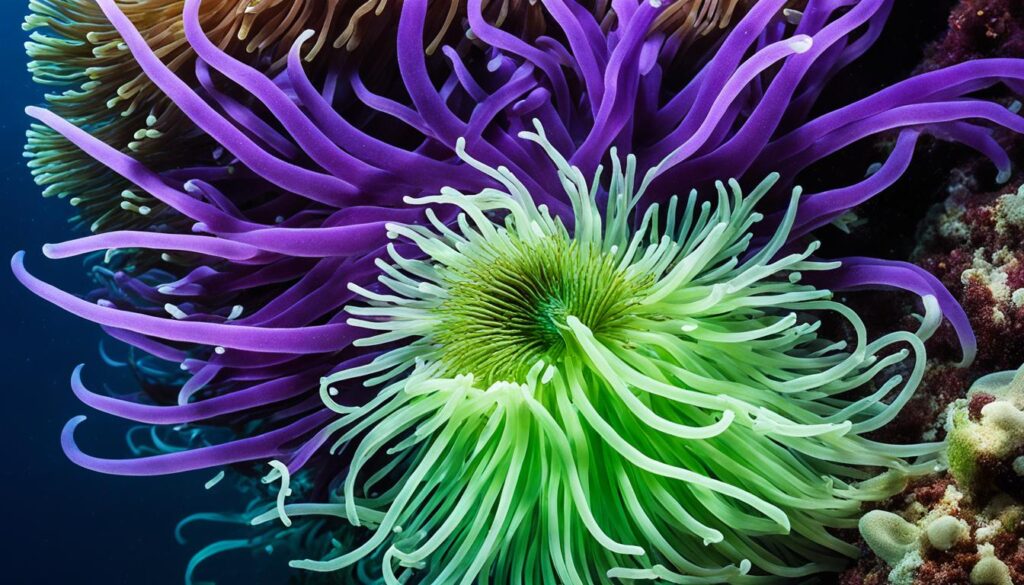
Conclusion
The ocean’s duelers, the mantis shrimp and the pistol shrimp, are truly extraordinary creatures. Their remarkable adaptations and astonishing abilities make them formidable combatants in the underwater realm. These fascinating creatures engage in battles to protect their homes, secure mates, and establish dominance, showcasing the captivating complexities of underwater combat.
From the pistol shrimp’s ability to produce shockwaves and create vortex-like motions to the mantis shrimp’s lightning-fast strikes, their combat strategies are a testament to the wonders of the natural world. These creatures have evolved diverse adaptations that allow them to thrive in their unique underwater habitats and excel in their confrontations with rivals. The ongoing exploration of mantis shrimp versus pistol shrimp continues to provide insights into the intricate mechanics of their combat strategies.
The remarkable adaptations of the mantis shrimp and the pistol shrimp serve as a reminder of the incredible diversity and ingenuity found in the animal kingdom. As we delve deeper into the study of underwater combat, we gain a deeper appreciation for the complexities and adaptations that have evolved over millions of years. The battles between these oceanic duelers reveal the immense creativity and resilience of these fascinating creatures.
In conclusion, the mantis shrimp versus pistol shrimp rivalry is not just a clash of titans, but a window into the world of underwater combat. Their remarkable adaptations, fascinating behaviors, and captivating strategies are a source of endless fascination and wonder. As we continue to uncover the secrets of these oceanic combatants, we gain a greater understanding of the incredible diversity and beauty that exists beneath the waves.



